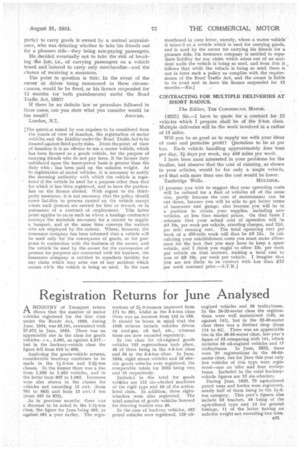Registration Returns for June Analysed
Page 41

If you've noticed an error in this article please click here to report it so we can fix it.
AMINISTRY of Transport return shows that the number of motor vehicles registered for the first time under the Roads Act, 1920, during June, 1934, was 33,161, contrasted with 27,072 in June, 1933. There was an appreciable rise in the class for goods vehicles-1 e., 5,691, as against 4,517— but in the hackney-vehicle class the figure fell from 619 to 609.
Analysing the goods-vehicle returns, considerable headway continues to be made in the 11-2-ton and 2-2i-ton classes. In the former there was a rise from 1,290 to 1,453 vehicles, and in the latter from 807 to 1,092. Increases were also shown in the classes for vehicles not exceeding 12 cwt. (from 761 to 983) and from 12 cwt.-1 ton (from 587 to 875).
As in previous months, there was a decrease to be noted in the 1-1/-ton class, the figure for June being 458, as against 581 a year earlier. The regis trations of 21-3-tonners improved from 171 to 281, whilst in the 3-4-ton class there was an increase from 153 to 189. It should he borne in mind that the 1933 returns include vehicles driven on coal-gas, oil fuel, etc., whereas these are now recorded separately.
In the class for oil-engined goods vehicles 132 registrations took place, 48 of them being in the 4-5-ton class and 34 in the 3-4-ton class. In June, 1934, eight steam vehicles and 28 electric goods vehicles were registered, the comparable totals for 1933 being two and 16 respectively.
Included in the total for goods vehicles are 112 six-wheeled machines of the rigid type and 59 of the articulated class. In addition, three eightwheelers were also registered. The total number Of goods vehicles licensed for drawing trailers was 40.
In the case of hackney vehicles, 452 petrol vehicles were registered, 129 oil engined vehicles and 28 trolleybuses. In the 26-32-seater class the registrations were well maintained (140, as against 141), but in the 32-40-seater class there was a distinct drop (from 114 to 61). There was an appreciable rise in the 48-56-seater class, last year's figure of 52 comparing With 141, which includes 59 oil-engined vehicles and 17
trolleybuses. In June, 1933, there were 39 registrations in the 56-64seater class, but for June this year only five vehicles of this type were registered—one an oiler and four trolleybuses. Included in the total hackneyvehicle figures are 13 six-wheelers.
During June, 1933, 75 agricultural petrol vans and lorries were registered, nearly half of them being in the 1/-2ton category. This year's figures also include 53 tractors, 40 being of the agricultural type and 13 for general haulage, 11 of the latter having an unladen weight not exceeding two tons.




















































































